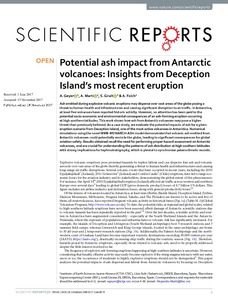Mostra el registre d'ítem simple
Potential ash impact from Antarctic volcanoes: Insights from Deception Island’s most recent eruption
| dc.contributor.author | Geyer, A. |
| dc.contributor.author | Marti, Alejandro |
| dc.contributor.author | Giralt, S. |
| dc.contributor.author | Folch, Arnau |
| dc.contributor.other | Barcelona Supercomputing Center |
| dc.date.accessioned | 2018-02-15T16:24:57Z |
| dc.date.available | 2018-02-15T16:24:57Z |
| dc.date.issued | 2017-11-28 |
| dc.identifier.citation | Geyer, A. [et al.]. Potential ash impact from Antarctic volcanoes: Insights from Deception Island’s most recent eruption. "Scientific Reports", 28 Novembre 2017, vol. 7. |
| dc.identifier.issn | 2045-2322 |
| dc.identifier.uri | http://hdl.handle.net/2117/114152 |
| dc.description.abstract | Ash emitted during explosive volcanic eruptions may disperse over vast areas of the globe posing a threat to human health and infrastructures and causing significant disruption to air traffic. In Antarctica, at least five volcanoes have reported historic activity. However, no attention has been paid to the potential socio-economic and environmental consequences of an ash-forming eruption occurring at high southern latitudes. This work shows how ash from Antarctic volcanoes may pose a higher threat than previously believed. As a case study, we evaluate the potential impacts of ash for a given eruption scenario from Deception Island, one of the most active volcanoes in Antarctica. Numerical simulations using the novel MMB-MONARCH-ASH model demonstrate that volcanic ash emitted from Antarctic volcanoes could potentially encircle the globe, leading to significant consequences for global aviation safety. Results obtained recall the need for performing proper hazard assessment on Antarctic volcanoes, and are crucial for understanding the patterns of ash distribution at high southern latitudes with strong implications for tephrostratigraphy, which is pivotal to synchronize palaeoclimatic records. |
| dc.description.sponsorship | A.G. thanks the support provided by the Ramón y Cajal research program (RYC-2012-11024). This research was partially funded by the MINECO grants VOLCLIMA (CGL2015-72629-EXP) and POSVOLDEC(CTM2016-79617-P)(AEI/FEDER-UE). We thank the Laboratorio de Astronomía, Geodesia y Cartografía (Universidad de Cádiz) for providing the Digital Elevation Model and all shapefiles required to build Fig. 2. The authors are grateful to Karoly Nemeth and an anonymous reviewer for their insightful comments and review of the manuscript, which have helped us improve this work. We also thank the Editor Alessandro Aiuppa for handling this paper. English editing by Terranova Scientific. |
| dc.format.extent | 10 p. |
| dc.language.iso | eng |
| dc.publisher | Nature Publishing Group |
| dc.rights | Attribution-NonCommercial-NoDerivs 4.0 Spain |
| dc.rights.uri | http://creativecommons.org/licenses/by-nc-nd/4.0/es/ |
| dc.subject | Àrees temàtiques de la UPC::Energies |
| dc.subject.lcsh | Volcanic activity prediction |
| dc.subject.other | Explosive volcanic eruptions |
| dc.subject.other | Antarctica |
| dc.title | Potential ash impact from Antarctic volcanoes: Insights from Deception Island’s most recent eruption |
| dc.type | Article |
| dc.subject.lemac | Activitat volcànica--Previsió |
| dc.description.peerreviewed | Peer Reviewed |
| dc.relation.publisherversion | https://www.nature.com/articles/s41598-017-16630-9 |
| dc.rights.access | Open Access |
| dc.description.version | Postprint (published version) |
| dc.relation.projectid | info:eu-repo/grantAgreement/MINECO//CGL2015-72629-EXP/ES/VOLCANES Y CLIMA: REEVALUACION DE SU INTERACCION A CORTO Y LARGO PLAZO/ |
| local.citation.publicationName | Scientific Reports |
| local.citation.volume | 7 |
| dc.identifier.pmid | 29184137 |
Fitxers d'aquest items
Aquest ítem apareix a les col·leccions següents
-
Articles de revista [273]


